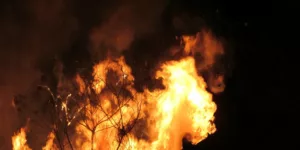One of the issues concerning forest fires is knowing about them soon enough to be easily contained. Fires spread quickly, but a relatively small team or single airdrop of water or fire retardant could put it out if you can catch it early. Currently, the most common ways to identify forest fires are observation towers and citizen reports. But the observation towers often don’t catch fire soon enough because, when the fire becomes visible to them, it has often already started to spread rapidly, and citizens can’t report a fire if they have no Cell service, and forests often have no cell service.
But what if we instrumented forests so that the forest itself could report a fire. The solution would need to be very dense because you want to identify the fire before it spreads, and that means it needs to use inexpensive sensors that network with each other to keep the individual cost down and cover-up.
There is already this kind of solution in place in the Rain Forest to catch the people who are killing it, and, I think, it could be modified to address the West Coast and European forest fire problems. It is one of the more interesting uses of AI, and The Rainforest Connection did it. This non-profit organization upcycles old Huawei cell phones into tree sensors to successfully catch illegal loggers and poachers.
Let’s talk about keeping the West Coast from burning this week.
Rainforest Connection
The Rainforest Connection solution modifies old smartphones, which would otherwise likely end up in landfills so that they will be alert if they hear a chainsaw or a spider monkey in distress. Spider Monkeys assist the Rain Forest by spreading seeds, and they are an integral part of keeping the Rain Forest viable, but listening for sounds can be problematic because mosquitos, up close, sound a lot like chainsaws and can result in false positives.
To solve these problems, Huawei worked with expert animal translators to develop an AI model and trained an AI to differentiate between the sounds and only alert when there was a real problem. Not only did they significantly improve the accuracy of detection, but they were able to reduce significantly the amount of time it took to make that detection from 1 second to 500 milliseconds.
Applied To Fires
Fires make a sound as they cook the liquids out of trees and plants; they also generate heat and light, which might require additional sensors or a creative way to use the cell phones’ built-in cameras and internal heat sensors. In addition, a sensor to suddenly show a heat-based failure might also rapidly determine if there was a fire present. Launching a high-speed drone could then confirm the fire, and you could also use if the fire remained small enough, drones like those being developed for refueling to carry flame retardant to put the small fire out. Larger fires could be addressed by multiple drones or even drone swarms that could respond far more quickly than existing human-crewed aircraft and be kept much nearer to where fires are likely to emerge.
Typical aircraft-based solutions require airfields to launch and store the aircraft, adding hours to the response time. This extra time allows the fires to grow pretty much ensuring they are too large for the aircraft to put out by the time they arrive. A combination of these cell phone-based sensors and a drone response, potentially, could make most large forest fires a thing of the past.
Though fires during high winds might require a specialized solution that would allow more rapid delivery of an immense amount of retardant. But it is using a type of drone that can still perform in high winds.
Wrapping Up:
The Rainforest solution that Huawei helped create could be modified to address the critical forest fire problem in the US and EU. It not only is a low-cost solution to a high-cost problem, but it keeps those cell phones out of landfills and reduces the amount of eWaste that is slowly contaminating the planet. Today’s tools to fight forest fires are inadequate for the size and frequency of fires we have today, and we need an innovative solution. We got innovative with the Rain Forests; let’s take what we learned, and address the spreading wildfire threat before losing another town or city.








